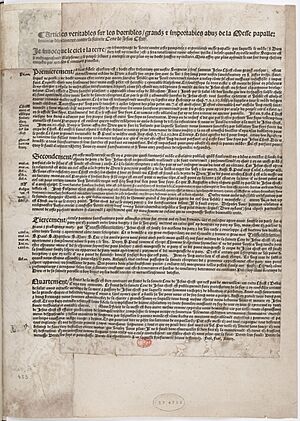Affair of the Placards facts for kids
The Affair of the Placards (known in French as Affaire des Placards) was a major event in French history. It happened on the night of October 17 to 18, 1534. During this night, anti-Catholic posters appeared in public places across Paris. They also showed up in four other important French cities: Blois, Rouen, Tours, and Orléans.
One of these posters was even put on the bedroom door of King Francis I at his castle, Amboise. This was a huge insult and a serious security breach. It made the King very upset. Before this event, King Francis I had tried to protect Protestants from harsh actions by the Parlement de Paris, which was a powerful court. He had also listened to calls for peace from people like Philip Melanchthon. But the Affair of the Placards ended these peaceful efforts.
What Were the Placards?
The posters had a very strong title: "Genuine articles on the horrific, great and unbearable abuses of the papal mass, invented directly contrary to the Holy Supper of our Lord, sole mediator and sole savior Jesus Christ." This title was a direct attack on the Catholic understanding of the Eucharist. The Eucharist is a central religious ceremony for Catholics.
The text on the posters supported the views of Huldrych Zwingli, a Protestant leader. Zwingli's ideas disagreed with the Catholic belief in the Real Presence during the Mass. The Real Presence is the belief that Jesus Christ is truly present in the bread and wine used during the Mass.
Many people believe that a French Protestant leader named Guillaume Farel was the main person behind these posters. However, it is more likely that Antoine de Marcourt wrote them. Marcourt was a pastor from Neuchâtel, Switzerland. A writer named Antoine Froment said that "these placards were made at Neuchâtel in Switzerland by a certain Antoine Marcourd." Marcourt himself later claimed credit for the posters in a book he wrote in November 1534. He said he was "moved by true affection to compose and edit in writing some true Articles on the unbearable abuses of the Mass." He wanted these articles to be "published and posted throughout the public places of the land."
What Happened Next?
After the posters appeared, religious parades were quickly announced for all the churches in Paris the following Sunday. In Paris, King Francis I himself took part in the procession. He stood under the special canopy where the Eucharist was usually carried. This was a clear public statement that he supported the Catholic faith.
A reward of one hundred écus (a type of old French coin) was offered. This reward was for anyone who could give information leading to the arrest of the people who put up the posters. Those found guilty would face severe punishment. People who supported the Protestants were soon found and sent to the Châtelet, a famous prison.
The first punishments were announced on November 10, 1534. The first person to be executed, on November 13, was a man named Barthélemi Milon. The strong words against the Catholic Church were seen as a huge insult by Catholics. The King then publicly confirmed his strong Catholic faith.
Many important Protestant leaders had to flee France right away. These included John Calvin, who later became a very important figure in the Protestant Reformation. Scholars and poets, like Clément Marot, also had to leave.
On January 13, 1535, another event happened. King Francis had just returned to Paris. More pamphlets about the Sacraments (holy rituals in the church) were left in the streets and doorways of Paris. After this, the King made a royal order that banned all printing.


